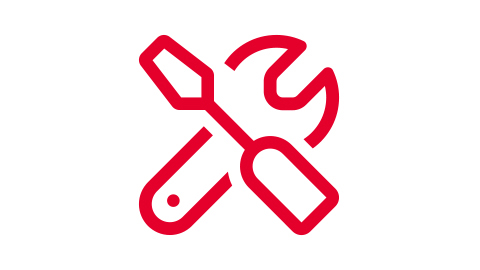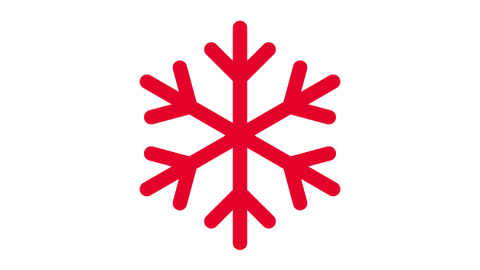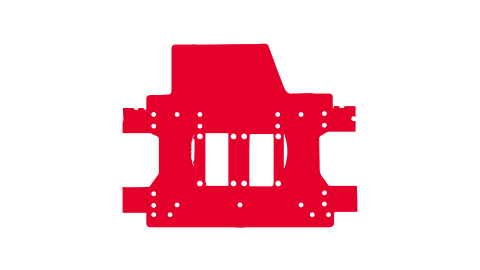Answering some common questions about telehandler maintenance

Keeping a telehandler well-maintained comes with nothing but advantages. Adhering to a fixed schedule of pre-use inspections and preventive maintenance is not only key to keeping the machine running smoothly and safely. It also extends the equipment's lifespan and reduces the risk of unexpected downtime, which saves money in many ways. Therefore, it is unsurprising that “how to properly maintain a telehandler” is a hot topic. In this blog, we answer some of the most common questions regarding maintenance.
How to maintain a telehandler?

Routine maintenance
Before starting work with a telehandler, the operator should perform routine maintenance. This includes visually inspecting the machine and checking some critical components to verify everything is in working order and the telehandler is safe to use.
Some things that should be done during routine checks are (in no particular order):
- Ensuring that there is no damage to the machine like split welds, metal cracks, or any other type of structural damage;
- Checking all fluid levels, including engine coolant and oil, hydraulic fluid, brake fluid, etc.
- Inspecting the hoses for signs of wear and checking for leaks;
- Checking and changing filters;
- Ensuring that the tyres are not cracked or otherwise damaged and – if the tyres are air-filled – checking whether they are filled to the correct amount;
- Inspecting stickers, decals and labels and replacing them if they are damaged or illegible.
- Inspecting the attachments for signs of damage;
- Etc.
In addition to the above inspections, the operator should carry out function tests to confirm that all basic parts and functions are in proper working order. This includes testing the steering and braking, ensuring that all boom and attachment controls are working, checking the Load Stability Indicator (LSI), and more. If these tests reveal any problems, the telehandler should not be used until repairs have been made.
Note that these checks and tests should only be carried out when the telehandler is parked on a level surface with the boom in a vertical position. The operator should also always refer to the machine’s operation and maintenance manuals for a comprehensive list of all required inspections.
Preventive maintenance
Telehandlers should undergo thorough inspections in addition to the daily checks carried out by the operator. During preventive maintenance, a technician looks for incipient problems and minor defects before they can develop into more serious defects and subsequent machine breakdown. If the inspection reveals issues, these should be addressed and all necessary parts replaced before the telehandler can be used again.
For some parts, such as tyres, it is easier to tell when they need replacing because they show telltale signs of wear. However, it is always best to consult the machine manual, which contains guidelines on how much wear is acceptable for specific components. The manual also indicates how often preventive maintenance should be carried out (more on this later). It is important to keep to this predetermined schedule, as timely maintenance ensures that problems don’t get worse because they go undetected for a long time.
For more information on routine and preventive maintenance, see our blog on why construction equipment maintenance matters.
How often should you grease a telehandler?

As a telehandler has many pivot points, greasing is essential for proper operation and to extend the machine’s lifespan. Greasing should therefore be carried out regularly: every 50 working hours or weekly is a good rule of thumb.
Always check the machine manual to identify the correct grease and all the grease points for a specific telehandler model. Common grease points include the stabiliser legs (if the telehandler has them), the front and rear of the boom, the cylinders, the attachment, the steering axle, and more—depending on the model. After greasing, make sure to run the machine through its functions several times to distribute the grease evenly. Additional greasing is required if the telehandler has been thoroughly cleaned, for example with a pressure washer or steam cleaner.
Note that some telehandler manufacturers have equipped their machines with an automatic system that eliminates the need for manual greasing. This not only saves time but also means you don’t have to deal with hard-to-access grease points. An automatic grease system consists of a grease tank and one or more greasing circuits (either one for the whole machine or several separate ones) that ensure optimum greasing. The system is also equipped with various alarms to notify any issues with the system, such as an empty tank or loss of pressure in the system.
What is the maintenance schedule for a telehandler?

To keep a telehandler in excellent working order, it’s crucial to follow a regular maintenance schedule.
Pre-use inspection
Before starting the telehandler, the operator should perform the routine maintenance tasks mentioned above. An important aspect of this is visually inspecting the machine and checking critical components. In practice, the pre-use inspection should be carried out daily or whenever a new operator takes over the telehandler, for instance, at shift change.
General maintenance and major inspections
In addition to the daily pre-use inspection, telehandlers should undergo regular general maintenance and major inspections. These should be scheduled at regular intervals, but the exact interval depends on, among other things, the machine itself, the environment in which it is typically used and the manufacturer’s guidelines. However, general maintenance is ideally scheduled at certain operation milestones; many telehandler manufacturers recommend every 50 working hours as a rule of thumb.
Telehandlers should also be subject to major inspections during which all the internal workings of the machine — including batteries and connectors, electrical parts, hydraulics, etc. — are checked. Again, you should refer to the machine manual to know the exact interval, but a common guideline is to do it quarterly.
How to maintain a telehandler during winter?

While some machines, such as small earth-movers, may hibernate during the winter months, telehandlers usually don’t. Their versatility means they are often used all year round in demanding environments such as construction and agriculture. Of course, this makes it important that telehandlers can withstand the more challenging winter weather conditions such as cold temperatures, snow and ice. Not only for the machine itself but also for the comfort and safety of the operator and anyone working around the machine. Therefore, it’s advisable to follow some maintenance tips.
Pay extra attention during the pre-use inspection
While it’s always important for the operator to visually inspect the telehandler before use, it’s even more so during winter. Some components require extra attention to ensure safety:
- Cold temperatures can significantly impact battery performance, so it’s essential to inspect batteries and the charging system carefully;
- The hydraulic system also demands extra care: look for leaks and defects, and confirm that the hydraulic fluid hasn't thickened;
- Proper traction is critical in icy and snowy conditions, making it essential to verify that the tyres are in good condition to maintain stability and manoeuvrability;
- Daylight hours are limited in winter, so ensure that the lights are functioning correctly and that all reflective surfaces are clean and visible.
Pick the right fluids and grease
Another winter precaution is to use cold-weather fluids to ensure a telehandler continues to function properly. Add engine antifreeze and opt for oils, coolants and fuels suitable for cold conditions. You should always refer to the machine manual for all information on the types of fluids required for the temperature range in which the telehandler will be used. The manual will normally also give guidance on how to operate the machine in these conditions.
Earlier in this blog, we already mentioned the importance of grease for the proper operation of telehandlers. However, cold conditions can cause grease to thicken and become less effective, which is detrimental to a telehandler. That’s why you should use special grease for cold temperatures. The machine manual will specify what grease the manufacturer recommends.
Keep a clear view
When working with a telehandler, the operator should always have a clear view of the job site to ensure maximum safety and efficiency. Therefore, it’s necessary to defrost the windows before starting the work day and check them for damage, as temperature fluctuations increase the risk of cracking. The operator should also check the windshield wipers during the pre-use inspection and replace the wiper blades if needed.
How to maintain a telehandler in hot weather?

Scorching summer days can be just as unforgiving on telehandlers as the cold. So, in addition to the usual pre-use checks, some components require extra attention to ensure the machine can beat the heat:
- All fluids should be at the correct levels. Some fluids require a different mixture to withstand higher temperatures. The machine manual contains more information on when this applies to specific fluids;
- As well as ensuring that all fluids are at the correct level, it is important to check the hoses for damage, as they can wear out more quickly in hot weather;
- To prevent overheating, thoroughly clean the radiator and cooling system on a regular basis to ensure they are free-flowing. For the same reason, the fan and fan drive belt should be properly adjusted;
- Regularly clean the air flow passages so that hot air in the engine is constantly exchanged with cooler outside air. This will also prevent overheating.
- And last but not least, warm days must also be workable for the operator. Therefore, regularly check the air conditioning system in the cabin.
How should telehandler attachments be maintained?

Not only a telehandler, but also its attachments require regular maintenance. That’s why a visual inspection of the attachment should also be included in the telehandler’s pre-use check.
In addition, preventive maintenance is required after 100 working hours. This includes a thorough inspection of the attachment for damage and loose or missing bolts, and checking the hydraulic hoses for signs of wear and damage.
Looking for parts?
- Click here to check out our complete parts range for telehandlers.
- Visit our online shop to order parts and accessories for telehandlers.
- Please feel free to contact us if you have any other questions.
Want to read more about maintenance?
Then the following blogs might also be interesting for you:
About the authors
This blog post is brought to you by your construction equipment marketing team.
Request your customer account to shop parts online
Submit the application form to specify your business needs and request your customer account.
Our sales team will contact you within 3 business days to talk about your business needs and complete registration.
After your account is set up, you will receive a personal login to our online shop. We will guide you in finding parts and placing your first order.
Request your account
Over 75.000 customers trust TVH as their spare parts supplier to ensure their client’s equipment fleet is running smoothly and efficiently. It starts with a customer account.